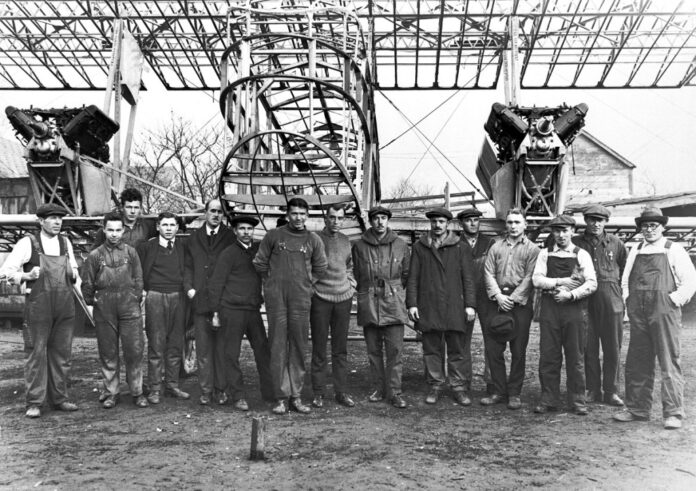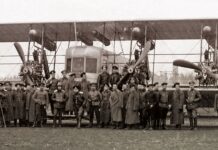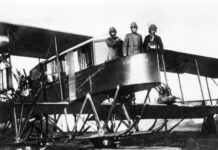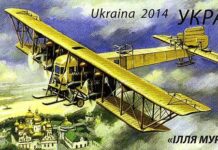“I want to recommend urgently the speedy construction of the new type of huge bomber.” “I have no question in my mind that you are right,” replied Mr. Shidlovsky. “Design and build three of the new planes as quickly as you can.” …The plane was designed, and several structural and aerodynamic tests were completed; then the ship was built, transported to the airport, assembled, checked and finally test-flown. From the time I received the order to start the preparation of drawings to the day when the new “Ilia Mourometz V” made its first flight exactly seven weeks went by. With the same four engines, and similar lifting capacity, the plane was almost twenty miles faster and could reach an altitude of 10.000 feet with full military load, instead of the 6,000 feet of the previous type. This was very satisfactory for a heavy bomber of 1914…
The Staff of the First Army had telegraphed the following to the Head Inspector-General of Aviation:
(Approximate date. March. 1915.) According to the Staff orders. the aircraft ‘Ilia Mouromets Kievsky‘ completed six battle flights, during which she was given reconnaissance problems and orders for the destruction of enemy railway terminals. The reconnaissance flights rendered very valuable information due to convenience of observation and the possibility of taking photographs of the enemy positions. According to the Intelligence Service conducted later, the bombing of the enemy railway terminals was very successful. Experience of the first series of flights showed that such type of aeroplane may give very promising results for reconnaissance as well as for bombing operations. The flights were conducted at an altitude of 5,300 metres and lasted up to four and a half hours. We may state that this type of Aircraft, due to its tactical qualities, deserves every encouragement in development. And its future usefulness in military operations will depend on an adequate supply of well trained men in each squadron.”
… Valuable observation flights far into the enemy territory were successfully completed. In more important cases, an officer from the staff was on board, and when conditions for observation were good, the big planes working with maps and photography, brought back more complete and reliable information than could be obtained from a small open plane of that time. With a large crew and powerful armament, they could penetrate farther when some military mission made this desirable.
Significant results were also obtained in bombing raids. The character of warfare on the Eastern Front, with considerable shifting of troops, and a limited number of roads, made particularly important attacks on railway stations and bridges. Heavy damage was inflicted many times. Twice the large ships succeeded in blowing up munition trains. One of these successful bombing attacks took place at the Prjevorsk station in Austria on June 5, 1915. The flying ship, under the command of Captain I. Baschko, located a munitions train about which the Third Aimy had secret information and, throwing a series of bombs, made a hit that started a huge explosion and fire. It was established later that about 30,000 shells were destroved, together with the train. The station buildings were badly damaged.
… The officers of the squadron worked out a scheme for mounting a machine-gun at the rear of the fuselage, and I was given the problem of designing it. I increased the stabilizer so as to take care of the weight of a man with a machine-gun and ammunition. The middle rudder was removed and was replaced by two large rudders located far from the centre line. At the end of the fuselage a cockpit was arranged for the gunner, with a sort of a windshield as protection from the stream of air… It was difficult to provide means of reaching the rear gunners’ nest in flight, because inside the fuselage were wire crosses which made the passage slow and inconvenient A device was invented which the firing news called the “trolley car.” It consisted of a pair of light rails running along the whole fuselage from the cabin to the rear gunner’s nest and of a low couch mounted on rollers. When necessary, a man could lie down on the couch and move easily below the wire (tosses of the fuselage…
During the fall of 1916, two new types of planes were finished and placed in service. They were “Ilia Mourometz G” and “Ilia Mourometz E.” The first one was in general similar to the former planes, but had a total of 740 h.p. instead of the 640 of the previous ships. The second type, the “Ilia Mourometz E,” was the largest plane produced. It had four Renault motors totalling 880 h.p. The plane had a wing area of 2,050 square feet; the gross weight was 17,600 pounds, of which 6,600 pounds represented the useful load…
Both new types of “Ilia Mourometz” had rear machine-gunners’ nests. This installation proved to be extremely valuable and workable. The most dangerous attacks from behind could now be met with fire from the rear machine-gun. After that time not one single “ Ilia Mourometz ” was brought down while more than two hundred bombing raids were made. It is reliably estimated that at least nine pursuit planes were destroyed by the fire from our ships during the battles in the air
Altogether, about seventy-five four-engined ships were built and delivered to the Front. About one-half of this number actually participated in air raids, while the rest were used for training purposes. A total of about four hundred raids were made with only one plane lost. Important military results were achieved that far more than justified the use of the modest number of men and expenses connected with the creation and activity of the squadron…” [I. Sikorsky, Winged S]
Real name of the Kyiv knight after whom the plane was named >










